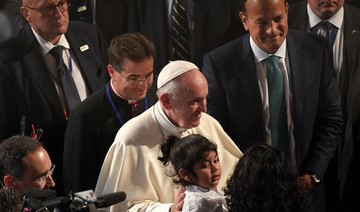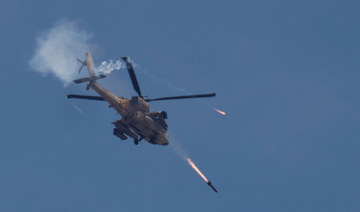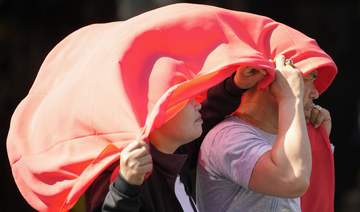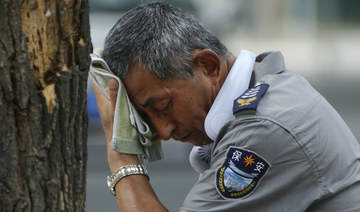KNOCK, Ireland: Pope Francis on Sunday begged forgiveness for the multitude of abuses suffered by victims in Ireland at the hand of the church over decades as he concluded a tour of the once deeply Catholic country watched by parishioners and protesters.
After meeting privately with abuse victims on Saturday on the first papal visit to Ireland in almost four decades, Francis apologized to mothers estranged from their children in church-run homes, children abused by priests and those exploited in religious schools, calling it a “state of shame.”
“To survivors of abuse of power, conscience and sexual abuse, recognizing what they have told me, I would like to put these crimes before the mercy of the Lord and ask forgiveness for them,” Francis told a mass attended by more than 100,000 people at Dublin’s Phoenix Park.
“We apologize for some members of the hierarchy who did not take care of these painful situations and kept silent.”
Years of sexual abuse scandals have shattered the credibility of the Church which four decades ago dominated Irish society. In the past three years, Irish voters have approved abortion and gay marriage in referendums, defying the Vatican.
Pressure on the pope over church abuse increased elsewhere on Sunday when a former top Vatican official accused Francis of having known of allegations of sex abuse by a prominent US cardinal for five years before accepting his resignation last month.
The declining influence of the Catholic Church has been demonstrated by crowds far smaller than those that met Pope John Paul II during the last Papal visit in 1979, when more than three-quarters of Ireland’s population turned out.
While 500,000 people snapped up tickets to see Francis say mass, local media quoted police recording the numbers as estimating some 130,000 arrived in the rain at the same spot where Pope John Paul II stood 39 years ago. Tens of thousands more prayed with him at the Knock shrine in the west of Ireland.
Francis, facing sexual abuse crises in several countries, wrote an unprecedented letter to all Catholics last week asking each one of them to help root out “this culture of death” and vowing there would be no more cover ups.
Some who turned out on the misty morning in Knock, where a group of locals in 1879 said they saw an apparition of the Virgin Mary, said Francis should be given time to deal with the abuse issues that have rocked the Church for decades.
“People have to give this man a chance, he’s trying his best,” said Carmel Lane, who traveled from County Longford in the midlands.
One Irish survivor of clerical abuse who met the pope on Saturday, Paul Redmond, told Reuters the strong language used by Francis at the meeting gave him hope that something might be shifting in the church.
Ireland’s Deputy Prime Minister, Simon Coveney, also said Francis’ promise of decisive action on abuse was very welcome, but told broadcaster RTE that “people will clearly be watching now after this visit to see what actions follow.”
However thousands of people joined survivors, their families and supporters at an event elsewhere in Dublin as the pope said mass to stand in solidarity with those who had suffered.
“It (the visit) has been very, very painful,” said Graham Mills, 52, who was sexually abused as a child by a member of the Christian brothers religious order and traveled from Northern Ireland to join the protest.
“I think Pope Francis is probably a very decent human being. But yesterday I was very disturbed by the big celebration for him knowing the lives that have been destroyed.”
Grammy Award-nominated Irish singer Hozier performed his hit “Take Me To Church” as abuse survivors addressed the crowd who were then asked to walk in silence to the last of Ireland’s former notorious Magdalene laundries that remains standing.
Hundreds also gathered in the western town of Tuam for a vigil at the site of a former church-run home for unwed mothers where an unmarked grave with the remains of hundreds of babies stored in underground chambers was found in 2014.
“My mother’s baby died in there at 6-years-old, it’s an obscenity. We’re standing on a place where unburied babies, 796 of them, are in a septic tank,” said Annette McKay, 64, who traveled from Britain for the vigil.
“Your (Francis’) church did this to 796 innocent children and their mothers. Tell me how you are going to change this.”
In Ireland Pope begs forgiveness for ‘betrayal’ of Church abuse
In Ireland Pope begs forgiveness for ‘betrayal’ of Church abuse

- Francis privately met with 8 victims of clerical, religious and institutional abuse
- Years of sexual abuse scandals have shattered the credibility of the Church
Filipino activists and fishermen sail in 100-boat flotilla to disputed shoal guarded by China

- Philippine coast guard and navy deploy one patrol ship each to keep watch from a distance on the activists and fishermen
- China effectively seized the Scarborough Shoal, a triangle-shaped atoll with a vast fishing lagoon, in 2012
The Philippine coast guard and navy deployed one patrol ship each to keep watch from a distance on the activists and fishermen, who set off on wooden boats with bamboo outriggers to assert Manila’s sovereignty over the Scarborough Shoal. Dozens of journalists joined the three-day voyage.
Activists and volunteers, including a Roman Catholic priest, belonging to a nongovernment coalition called Atin Ito — Tagalog for This is Ours — planned to float small territorial buoys and distribute food packs and fuel to Filipino fishermen near the shoal, organizers said, adding they were prepared for contingencies.
“Our mission is peaceful based on international law and aimed at asserting our sovereign rights,” said Rafaela David, a lead organizer. “We will sail with determination, not provocation, to civilianize the region and safeguard our territorial integrity.”
In December, David’s group with boatloads of fishermen also tried to sail to another disputed shoal but cut short the trip after being tailed by a Chinese ship.
China effectively seized the Scarborough Shoal, a triangle-shaped atoll with a vast fishing lagoon ringed by mostly submerged coral outcrops, by surrounding it with its coast guard ships after a tense 2012 standoff with Philippine government ships.
Angered by China’s action, the Philippine government brought the disputes to international arbitration in 2013 and largely won with a tribunal in The Hague ruling three years later that China’s expansive claims based on historical grounds in the busy seaway were invalid under the 1982 UN Convention on the Law of the Sea.
The ruling declared the Scarborough Shoal a traditional fishing area for Chinese, Filipino and Vietnamese fishermen. In the past, fishermen have anchored in the shoal to avoid huge waves in the high seas in stormy weather.
China refused to participate in the arbitration, rejected the outcome and continues to defy it.
Two weeks ago, Chinese coast guard and suspected militia ships used water cannons on Philippine coast guard and fisheries boats patrolling the Scarborough Shoal, damaging both craft.
The Philippines condemned the Chinese coast guard’s action on the shoal, which lies in the Southeast Asian nation’s internationally recognized exclusive economic zone. The Chinese coast guard said it took a “necessary measure” after the Philippine ships “violated China’s sovereignty.”
The Chinese coast guard has also reinstalled a floating barrier across the entrance to the shoal’s vast fishing lagoon, the Philippine coast guard said. The Philippine coast guard removed a similar barrier in the past to allow Filipinos to fish there.
In addition to the Philippines and China, Vietnam, Malaysia, Brunei and Taiwan have also been involved in the territorial disputes.
Chinese coast guard ships had also ventured into waters close to Vietnam, Malaysia and Indonesia in the past, sparking tensions and protests, but the Southeast Asian nations with considerable economic ties with China have not been as aggressively critical against Beijing’s increasingly assertive actions.
The Philippines has released videos of its territorial faceoffs with China and invited journalists to witness the hostilities in the high seas in a strategy to gain international support, sparking a word war with Beijing.
The increasing frequency of the skirmishes between the Philippines and China has led to minor collisions, injured Filipino navy personnel and damaged supply boats in recent months. It has sparked fears the territorial disputes could degenerate into an armed conflict between China and the United States, a longtime treaty ally of the Philippines.
Indonesia floods kill 58 as rescuers race to find missing

- Rescuers said many of the retrieved bodies were found in or around nearby rivers after locals were swept away by the deluge of volcanic material, mud and rain that tore through neighborhoods
Tanah Datar, Indonesia: Indonesian rescuers raced Wednesday to find dozens of people still unaccounted for after flash floods and cold lava flow that inundated neighborhoods and swept away houses over the weekend left 58 people dead.
Hours of torrential rain on Saturday caused mud and rocks to flow into districts near one of Indonesia’s most active volcanos, sweeping away dozens of houses and damaging roads and mosques.
“Based on the latest data... the number of people who died is 58,” national disaster agency chief Suharyanto said in a statement Wednesday.
He added that 35 people remained missing — up from local rescuers’ figure of 22 on Tuesday — and 33 people were injured.
Rescuers said many of the retrieved bodies were found in or around nearby rivers after locals were swept away by the deluge of volcanic material, mud and rain that tore through neighborhoods.
Cold lava, also known as lahar, is volcanic material such as ash, sand and pebbles carried down a volcano’s slopes by rain.
Heavy equipment was deployed to clear debris from the areas worst hit by flooding, which has affected transport access in six districts, said Suharyanto, who goes by one name.
More than 3,300 people have been forced to evacuate from affected areas.
To aid the rescue effort, authorities on Wednesday deployed weather modification technology, the term Indonesian officials use for cloud seeding.
In this case, it is being used in a bid to make clouds rain earlier so the rainfall’s intensity is weakened by the time it reaches the disaster-struck area.
Indonesia is prone to landslides and floods during the rainy season.
In 2022, about 24,000 people were evacuated and two children were killed in floods on Sumatra island, with environmental campaigners blaming deforestation caused by logging for worsening the disaster.
Trees act as a natural defense against floods, slowing the rate at which water runs down hills and into rivers.
Biden administration is giving $1 billion in new weapons and ammo to Israel, congressional aides say
Biden administration is giving $1 billion in new weapons and ammo to Israel, congressional aides say

- The package being sent includes about $700 million for tank ammunition, $500 million in tactical vehicles and $60 million in mortar rounds, the aides said
- Israel has killed more than 35,000 Palestinians in Gaza, mostly women and children, according to the health ministry in the Hamas-run territory
WASHINGTON: The Biden administration has told key lawmakers it is sending a new package of more than $1 billion in arms and ammunition to Israel, three congressional aides said Tuesday.
It’s the first arms shipment to Israel to be announced by the administration since it put another arms transfer — consisting of 3,500 bombs — on hold earlier in the month. The administration has said it paused that earlier transfer to keep Israel from using the bombs in its growing offensive in the crowded southern Gaza city of Rafah.
The congressional aides spoke on condition of anonymity to discuss an arms transfer that has not yet been made public.
The package being sent includes about $700 million for tank ammunition, $500 million in tactical vehicles and $60 million in mortar rounds, the aides said.
There was no immediate indication when the arms would be sent. Israel is now seven months into its war against Hamas in Gaza.
The Wall Street Journal first reported the plans to move the package.
House Republicans were planning this week to advance a bill to mandate the delivery of offensive weaponry for Israel. Following Biden’s move to put a pause on bomb shipments last week, Republicans have been swift in their condemnation, arguing it represents the abandonment of the closest US ally in the Middle East.
The White House said Tuesday that Biden would veto the bill if it were to pass Congress. The bill also has practically no chance in the Democratic-controlled Senate. But House Democrats are somewhat divided on the issue, and roughly two dozen have signed onto a letter to the Biden administration saying they were “deeply concerned about the message” sent by pausing the bomb shipment.
In addition to the written veto threat, the White House has been in touch with various lawmakers and congressional aides about the legislation, according to an administration official.
“We strongly, strongly oppose attempts to constrain the President’s ability to deploy US security assistance consistent with US foreign policy and national security objectives,” White House press secretary Karine Jean-Pierre said this week, adding that the administration plans to spend “every last cent” appropriated by Congress in the national security supplemental package that was signed into law by Biden last month.
Court probing Ukraine, Gaza wars vows to defy threats

- Israel has killed more than 35,000 Palestinians in Gaza, according to Gaza’s Health Ministry
- In May of last year Russia put Kahn on its list of wanted persons after the court issued an arrest warrant against President Vladimir Putin for his role in the deportation of Ukrainian children to Russia as part of the war
UNITED NATIONS, United States: The International Criminal Court prosecutor said Tuesday he will not be intimidated by threats as his office probes possible war crimes in Ukraine and Gaza.
During a UN Security Council meeting on his probe into war crimes in Libya, prosecutor Karim Khan was challenged by the ambassadors of Russia and Libya, who criticized what they called his inaction as Israel wages war on Hamas in the Gaza Strip.
“One wonders if the effectiveness of the ICC on this track is affected by the fact that a new bipartisan bill has been submitted to the US Congress to sanction ICC officials involved in investigating not only the US but also its allies,” said the Russian ambassador Vasily Nebenzia.
Nebenzia was alluding to news reports that a bill to this end has been submitted to the US Congress.
Khan responded by citing what he said were threats against him and his office to make him halt his probes.
“We will not be swayed, whether it’s by warrants for my arrest or the arrest of elected officials of the court by the Russian Federation, or whether it’s by other elected officials in any other jurisdiction,” Khan said.
In May of last year Russia put Kahn on its list of wanted persons after the court issued an arrest warrant against President Vladimir Putin for his role in the deportation of Ukrainian children to Russia as part of the war.
In early May Kahn’s office said on X that the court’s “independence and impartiality are undermined, however, when individuals threaten to retaliate against the court or against court personnel.”
It did not say where the threats are coming from.
“Such threats, even not acted upon, may constitute an offense” against the ICC’s “administration of justice,” the office warned, calling for an end to such activity.
The court made this comment after US and Israeli media reports which suggested the ICC prosecutor could issue warrants against Israeli politicians including Prime Minister Benjamin Netanyahu and Hamas leaders.
“We have a duty to stand up for justice, to stand up for victims,” Kahn said Tuesday.
“And I am fully cognizant that there are Goliaths in this room. There are Goliaths with power, with influence” he said.
He added: “We have something called the law. All I can do is say that we will stand up to the best of our ability. We will stand up by the law with integrity with independence.”
Sweltering heat across Asia was 45 times more likely because of climate change, study finds

ENGALURU, India: Sizzling heat across Asia and the Middle East in late April that echoed last year’s destructive swelter was made 45 times more likely in some parts of the continent because of human-caused climate change, a study Tuesday found.
Scorching temperatures were felt across large swaths of Asia, from Gaza in the west — where over 2 million people face clean water shortages, lack of health care and other essentials due to Israeli bombardment — to the Philippines in the southeast, with many parts of the continent experiencing temperatures well above 40 degrees Celsius (104 degrees Fahrenheit) several days in a row.
The study was released by the World Weather Attribution group of scientists, who use established climate models to quickly determine whether human-caused climate change played a part in extreme weather events around the world.
In the Philippines, scientists found the heat was so extreme it would have been impossible without human-caused climate change. In parts of the Middle East, climate change increased the probability of the event by about a factor of five.
“People suffered and died when April temperatures soared in Asia,” said Friederike Otto, study author and climate scientist at Imperial College in London. “If humans continue to burn fossil fuels, the climate will continue to warm, and vulnerable people will continue to die.”
At least 28 heat-related deaths were reported in Bangladesh, as well as five in India and three in Gaza in April. Surges in heat deaths have also been reported in Thailand and the Philippines this year according to the study.
The heat also had a large impact on agriculture, causing crop damage and reduced yields, as well as on education, with school vacations having to be extended and schools closed in several countries, affecting thousands of students.
Myanmar, Laos and Vietnam broke records for their hottest April day, and the Philippines experienced its hottest night ever with a low of 29.8 degrees Celsius (85.6 degrees Fahrenheit). In India, temperatures reached as high as 46 degrees Celsius (115 degrees Fahrenheit). The month was the hottest April on record globally and the eleventh consecutive month in a row that broke the hottest month record.
Climate experts say extreme heat in South Asia during the pre-monsoon season is becoming more frequent and the study found that extreme temperatures are now about 0.85 degrees Celsius (1.5 Fahrenheit) hotter in the region because of climate change.
Internally displaced people, migrants and those in refugee camps were especially vulnerable to the searing temperatures, the study found.
“These findings in scientific terms are alarming,” said Aditya Valiathan Pillai, a heat plans expert at New Delhi-based think tank Sustainable Futures Collaborative. “But for people on the ground living in precarious conditions, it could be absolutely deadly.” Pillai was not part of the study.
Pillai said more awareness about heat risks, public and private investments to deal with increasing heat and more research on its impacts are all necessary to deal with future heat waves.
“I think heat is now among the foremost risks in terms of personal health for millions across the world as well as nations’ economic development,” he said.




















